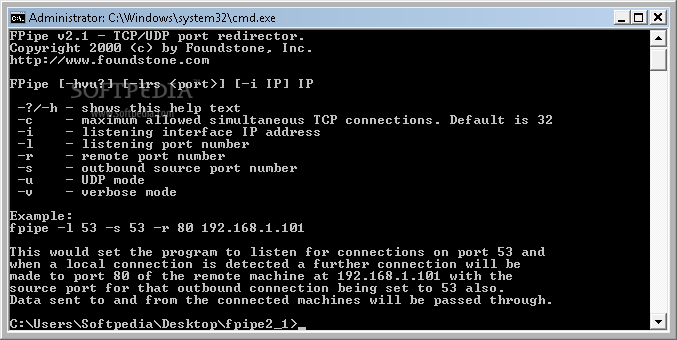Description
FPipe
FPipe is a handy application that helps you forward or redirect source ports. It allows you to create a TCP or UDP stream using a source port of your choice. This feature is super useful for getting around firewalls that only allow traffic on specific source ports, like 23, so you can connect to internal servers.
How FPipe Works
Typically, when you're using a client, it picks a random high-numbered source port. Unfortunately, firewalls often block these random ports. But guess what? They might let Telnet traffic through! This is where FPipe shines—by forcing the stream to always use a specific source port (like the Telnet one), it makes the firewall think it's an allowed service and lets the stream through.
The Indirection Magic
FPipe does its magic through indirection. You start FPipe with three key pieces: a listening server port, the remote destination port (which is the port you want to reach inside the firewall), and optionally, the local source port number you prefer. Once FPipe starts up, it waits for a client to connect on its listening port.
Create Your Connection Stream
When someone connects to FPipe’s listening port, it will then make a new connection to your desired destination machine and specified local source port—creating that much-needed stream! After this connection is set up, FPipe forwards all incoming data from its inbound connection straight to that remote destination past the firewall.
Where Can You Run FPipe?
You can run FPipe on the same machine where you're trying to access stuff behind the firewall or even on another server somewhere else!
A Real-Life Scenario
Imagine you want to telnet into an internal HTTP server that you've just compromised with MDAC. If there's a netcat shell waiting there but firewalls are blocking your way, here’s what you do: start FPipe, set it up with the netcat listener as your destination, choose a listening port and pick a source port that won't get blocked by the firewall. Now telnet into FPipe and voilà—you’re in!
A Word of Caution
If you're using the -s option to set an outbound connection's source port number and if that connection closes unexpectedly, re-establishing might be tricky! You could run into issues where FPipe claims the address is already in use until certain timeouts have passed—anywhere from 30 seconds up to over 4 minutes based on your OS version.
This happens because when FPipe tries reconnecting using those same IP/port combos from before, it can't until TCP decides everything from that last session has wrapped up completely.
If you're interested in checking out more about FPipe here!
User Reviews for FPipe 1
-
for FPipe
FPipe is a powerful tool for bypassing firewalls and accessing internal servers. Its source port manipulation feature is invaluable.

